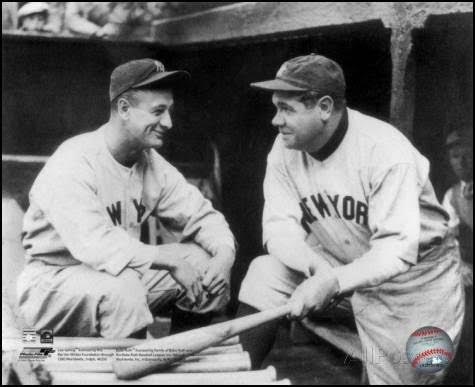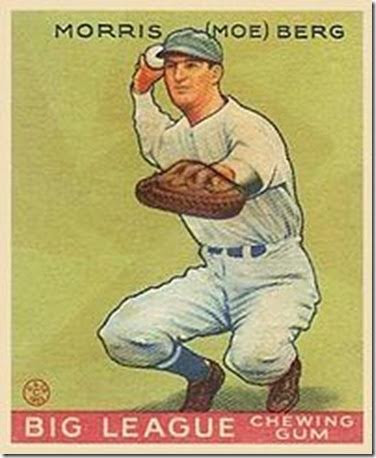Although he played with five major-league teams from 1923 to 1939, he was a very mediocre ball player.
But Moe had a secret and was regarded as the oddest ballplayer of the bunch.
In fact Casey Stengel once said: "That is the strangest man ever to play baseball.”
When all the baseball stars went to Japan, Moe Berg went with them and many people wondered why he tagged along.
 |
| Lou Gehrig and Babe Ruth |
Moe Berg was a United States spy, working undercover with the CIA and spoke 15 languages, including Japanese.
He had two loves: baseball and spying.
While in Tokyo, garbed in a kimono, Berg took flowers to the daughter of an American diplomat being treated in St. Luke's Hospital - the tallest building in the Japanese capital.
He never delivered the flowers. Nope.
The ball-player ascended to the roof and filmed key features of the surrounding city: the harbour, military installations, railway yards, etc.
Eight years later, General Jimmy Doolittle studied Berg's films in planning his spectacular raid on Tokyo.
 |
| Moe Berg |
His father disapproved of baseball and never once watched his son play. In Barringer High School, Moe learned Latin, Greek and French. Moe read at least 10 newspapers every day. Dad loved that part.
He graduated magna cum laude from Princeton - having added Spanish, Italian, German and Sanskrit to his linguistic quiver. During further studies at the Sorbonne, in Paris, and Columbia Law School, he picked up Japanese, Chinese, Korean, Indian, Arabic, Portuguese and Hungarian - 15 languages in all, plus some regional dialects.
While playing baseball for Princeton University, Moe would confuse opposing teams by calling pitches and plays using Latin or Sanskrit. A cunning skill he would later use to confuse messages in case of enemy capture.
 |
| Tito's Partisans |
During World War II, Moe was parachuted into Yugoslavia to assess the value to the war effort of the two groups of partisans there.
His report concluded, Yugoslavian underground fighter Marshall Tito's forces "are supported widely by the people," and in turn Winston Churchill ordered all-out support for the underground rather than Mihajlovic's Serbians.
The parachute jump at age 41 undoubtedly was a challenge. But there was more to come in that same year.
Berg penetrated German-held Norway, met with members of the underground and located a secret heavy-water plant exposing Nazi efforts to build an atomic bomb.
His information guided the Royal Air Force in a raid that destroyed the plant.
 |
| The R.A.F. destroys the Norwegian heavy water plant targeted by Moe Berg. |
There still remained however the question of how far had the Nazis progressed in the race to build the first Atomic bomb.
If the Nazis were successful, they would win the war. Berg (under the code name "Remus") was sent to Switzerland to hear leading German physicist Werner Heisenberg, a Nobel Laureate, lecture and his orders entailed determining if the Nazis were close to building an A-bomb. Moe managed to slip past the SS guards while posing as a Swiss graduate student.
He carried two things with him indicating the do-or-die nature of the mission: a pistol and a cyanide pill. If the scientist indicated the Nazis were close to building a weapon, Berg's orders were to shoot him dead and then swallow the cyanide pill. Talk about a suicide bunt scenario!
With Moe sitting in the front row and ready to pounce he determined that the Germans were nowhere near their goal. Instead he complimented Heisenberg on his speech and walked him back to his hotel, pistol and cyanide still in his pocket.
 |
| Warner Heisenberg - he blocked the Nazis from building an atomic bomb. |
Moe Berg's report was distributed to Winston Churchill, President Franklin D. Roosevelt and other key figures in the team developing the Atomic Bomb.
Roosevelt commended: "Give my regards to the catcher.”
Roosevelt commended: "Give my regards to the catcher.”
Most of Germany's leading physicists had been Jewish and had fled the Nazis mainly to Britain and the United States. Some say it was Berg who recommended to each that they escape or stand to suffer grave consequences.
After the war, Moe Berg was awarded the Medal of Freedom - America's highest honor for a civilian in wartime. But Berg refused to accept it, because he remained adamant about keeping his mission a secret.
After his death, his sister finally accepted the Medal. It now hangs in the Baseball Hall of Fame, in Cooperstown.
 |
| Presidential Medal of Freedom |
 |
| Moe Berg - sneaky catcher |
